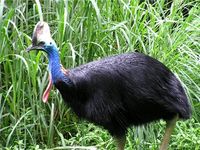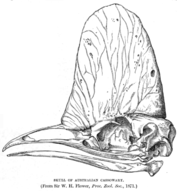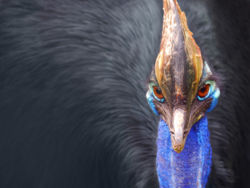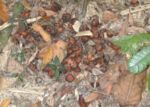Cassowary
2008/9 Schools Wikipedia Selection. Related subjects: Birds
| cassowary | ||||||||||||
|---|---|---|---|---|---|---|---|---|---|---|---|---|
 Southern Cassowary  |
||||||||||||
| Scientific classification | ||||||||||||
|
||||||||||||
| Species | ||||||||||||
|
Casuarius casuarius |
Cassowaries ( genus Casuarius) are very large flightless birds native to the tropical forests of New Guinea and northeastern Australia. Some nearby islands also have small cassowary populations, but it is not known if these are natural or the result of the New Guinea trade in young birds. They are frugivorous; fallen fruit and fruit on low branches is the mainstay of their diet. They also eat fungi, snails, insects, frogs, snakes and other small animals. They are a keystone species of rain forests because they eat fallen fruit whole and distribute seeds across the jungle floor via excrement.
Taxonomy and evolution
Cassowaries (from the Indonesian name kasuari) are part of the ratite group, which also includes the emu, rhea, ostrich, moa (now extinct), and kiwi. There are three species recognized today:
- Southern Cassowary or Double-wattled cassowary C. casuarius of Australia and New Guinea.
- Dwarf Cassowary C. bennetti of New Guinea and New Britain.
- Northern Cassowary C. unappendiculatus of New Guinea.
The evolutionary history of cassowaries, as of all ratites, is not well known. A fossil species was reported from Australia, but for reasons of biogeography this assignment is not certain and it might belong to the prehistoric "emuwaries", Emuarius, which were cassowary-like primitive emus.
Cassowaries are aggressive birds that nest on the ground. The Cassowary is the second largest flightless bird on the planet, second only to the ostrich. Although the Australian Emu can stand taller, it's overall size and weight is less than the Cassowary.
Description
The Northern and Dwarf Cassowaries are not well known. All cassowaries are usually shy birds of the deep forest, adept at disappearing long before a human knows they are there. Even the more accessible Southern Cassowary of the far north Queensland rain forests is not well understood.
The Southern Cassowary is the largest land creature in Australia and the second heaviest extant bird in the world after the ostrich. It is third tallest after the ostrich and emu.
Females are bigger and more brightly coloured. Adult Southern Cassowaries are 1.5 to 1.8 m (5 to 6 feet) tall, although some females may reach 2 m (6 feet 8 inches), and weigh about 70 kilograms (154 pounds).
A cassowary's three- toed feet have sharp claws; the dagger-like middle claw is 120 mm (5 inches) long. This claw is particularly dangerous since the Cassowary can use it to kill an enemy, disembowelling it with a single kick. They can run up to 50 km/h (32 mph) through the dense forest. They can jump up to 1.5 m (5 feet) and they are good swimmers.
All three species have horn-like crests called casques on their heads. These consist of "a keratinous skin over a core of firm, cellular foam-like material". Several purposes for the casques have been proposed. One possibility is that they are secondary sexual characteristics. Other suggestions include that they are used to batter through underbrush, as a weapon for dominance disputes, or as a tool for pushing aside leaf litter during foraging. The latter three are disputed by biologist Andrew Mack on the basis of personal observation. However, the earlier article by Crome and Moore says that the birds do lower their heads when they are running "full tilt through the vegetation, brushing saplings aside and occasionally careening [sic] into small trees. The casque would help protect the skull from such collisions." Mack and Jones also speculate that the casques play a role in either sound reception or acoustic communication. This is related to their discovery that at least the Dwarf Cassowary and Southern Cassowary produce very-low frequency sounds, which may aid in communication in dense rainforest. This "boom" is the lowest known bird call, and is on the edge of human hearing.
Females lay three to eight large, pale green-blue eggs in each clutch. These eggs measure about 9 by 14 cm (3½ by 5½ inches) — only ostrich and emu eggs are larger. The female does not care for the eggs or the chicks; the male incubates the eggs for two months, then cares for the brown-striped chicks for nine months, defending them fiercely against all potential predators, including humans.
Threats
Loss of habitat owing to the destruction of rainforest over the last 100 years has been the major factor in the decline of the Cassowary. For the last 20 years Mission Beach has experienced the greatest amount of lowland rainforest clearing in Australia. In the Mission Beach area alone, Cassowaries have lost about 50% of their critical habitat in the past ten years. The survival of many rainforest trees is tied to the Cassowary's survival.
Traffic is another big problem. Between 1st July and 30th September 2003 one Sub Adult bird was killed by a car in the Mission Beach area despite reduced speed limits, big warning signs and recent road improvements intended to make the roads safer for Cassowaries.
Hand feeding of Cassowaries poses a big threat to their survival. In suburban areas the birds are more susceptible to vehicles and dogs. Contact with humans encourages Cassowaries to take most unsuitable food from picnic tables.
Feral pigs are a huge problem. They probably destroy nests and eggs; but their worst effect is as competitors for food, which could be catastrophic for the Cassowaries during lean times. Pigs also contaminate water sources.
Dogs chase the birds away from potential food sources in suburban areas.
Interactions with humans
The 2004 edition of the Guinness World Records lists the cassowary as the world's most dangerous bird. Normally cassowaries are very shy but when disturbed can lash out dangerously with their powerful legs. During World War II American and Australian troops stationed in New Guinea were warned to steer clear of the birds. They are capable of inflicting fatal injuries to an adult human. Usually, attacks are the result of provocation. Wounded or cornered birds are particularly dangerous. Cassowaries, deftly using their surroundings to conceal their movements, have been known to out-flank organized groups of human predators. Cassowaries are considered to be one of the most dangerous animals to keep in zoos, based on the frequency and severity of injuries incurred by zookeepers.
Role in seed dispersal and germination
Cassowaries feed on the fruits of several hundred rainforest species and usually pass viable seeds in large dense scats. They are known to disperse seeds over distances greater than a kilometre, and thus probably play an important role in the ecosystem. Germination rates for seeds of the rare Australian rainforest tree Ryparosa were found to be much higher after passing through a cassowary's gut (92% versus 4%).

